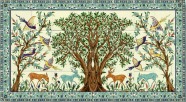I recently finished this ketubah for a couple who love to spend time in the woods in New Hampshire. They asked for a snowy scene of birch trees in the moonlight, with the tracks of a wolf and a bear. I added some little silvery evergreen trees, and the red branches of the willow, drawing on my memory of many winters spent in northern Wisconsin.
Looking for wildness locally, I took my daily walk by the forest preserve (Chipilli Woods) near my house. As I walked by the tree-lined clearing at dusk, I scanned the field for the sight of any wildlife. I had the uncanny feeling that something was watching me, and sure enough, my eyes rested upon a large coyote. I stopped and met its gaze. It didn’t flinch. Actually, it was pretty large and solid for a coyote, and not rangy and leggy like the ones I’ve seen around here. Could it be a wolf? There were no people around, and it really seemed wild, not like someone’s dog– especially the way it was WATCHING ME! When I’ve seen coyotes, they’re usually shy, and kind of keep to the edges of the woods. I’ve never seen a coyote hold its ground and just stare me down. It was staring at me the way I’ve seen hawks in the neighborhood stare at Yorkies.
Tomorrow I’ll go back to the field and see if I can find any tracks. Wolf-tracks (I now know, from painting them) are larger than dogs or coyotes. It’s unlikely I’ll be able to find them in a grassy field, but I’ll take a look, all the same. (In full daylight.)
What do you think? Have you heard of any wolf-sightings in Northern Illinois?







